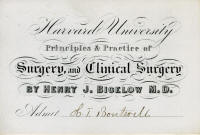Henry J. Bigelow,
M.D.

Click image to enlarge
Go to lecture card display
Henry J. Bigelow, M.D., LL.D., professor of
surgery at the Harvard Medical School, emeritus ; surgeon to the
Massachusetts General Hospital ; discoverer of the Y-ligament of the
hip, and of the operation of litholapaxy ; died October 30, aged
seventy-two.
Henry Jacob Bigelow,
M. D., died at his country house in Newton, on Thursday, October
30th, at the age of seventy-two.
For the last few years Dr.
Bigelow has been subject to gastric disturbances and attacks of
hepatic colic, and for several days before his death his stomach
refused to retain food. A post-mortem examination showed the
presence of gall-stones, and an inflammation of the common duct,
which had extended to the smaller bile-ducts, and was attended with
the formation of several small abscesses of the liver. There was
also a fibrous stenosis of the pylorus and a slight consequent
dilatation of the stomach. The pulmonary affection which was the
cause of a temporary abandonment of his medical studies in his early
manhood had left its traces at the apices of his lungs.
Dr. Henry J. Bigelow was born in
Boston on March 11, 1818. He was the son of Dr. Jacob Bigelow, who
left a name distinguished in the profession and by many acts of
public benefit. He prepared for college at the Boston Latin School,
and graduated at Harvard in the class of 1837. His medical studies,
which were pursued with his father and at Harvard, were interrupted
by ill health, and a consequent trip to Europe. His medical degree
was taken in 1841. He immediately returned to Europe, where he
passed three years in the further study of his profession, a greater
part of this time being spent in Paris. After his return to Boston
he was, in 1845, appointed Instructor in Surgery in the Tremont
Street Medical School, succeeding Dr. Reynolds. This position he
held until this school was united with the Medical School of
Harvard University. In 1846 he was appointed Surgeon to the
Massachusetts General Hospital. In 1849 he was appointed Professor
of Surgery, the two chairs of Surgery and Clinical Surgery,
previously held respectively by Dr. J. C. Warren and Dr. George
Hayward, being united.
A few months after his
appointment as Surgeon to the Hospital, ether was first used in the
hospital amphitheatre for surgical anaesthesia. Dr. Bigelow was one
of the first to see the value of the discovery, and he was specially
influential in extending the use of anaesthesia in surgical
operations. It was chiefly through his paper on the subject that the
knowledge of the wonderful discovery was made known.
Dr. Bigelow's writings have not
been voluminous, but as contributions to surgical knowledge they
have completely changed surgical practice in several particulars.
His interest in anaesthesia and anaesthetics has been repeatedly
shown by various articles on ether, nitrous oxide, and on rhi-
golene, a petroleum naphtha for producing anaesthesia by freezing.
The famous case of Dr. Harlow's of the passage of a crowbar through
the head was made known chiefly through Dr. Bigelow's interest and
study of the case. His work on "Dislocation of the Hip Joint" has
banished the old pulleys and rings for its adjustment from the
operating theatre.
His Litholapaxy has
revolutionized the treatment of stone in the bladder, and given rise
to a literature that far exceeds in volume the united writings of
its famous inventor.
But the mere enumeration of his
writings fails to show the great influence of the man. He had a
unique way of regarding all subjects that attracted his notice. The
hospital with which he was connected shows, in many places, his
originality and inventiveness. Acute, clear-sighted, and inventive
as he was, he was capable of most close and severe study. The hard
work which he bestowed upon the mechanism of the hip joint extended
over several years. His operation of lithola- paxy and the
instruments for its performance were the result of painstaking
labor.
|